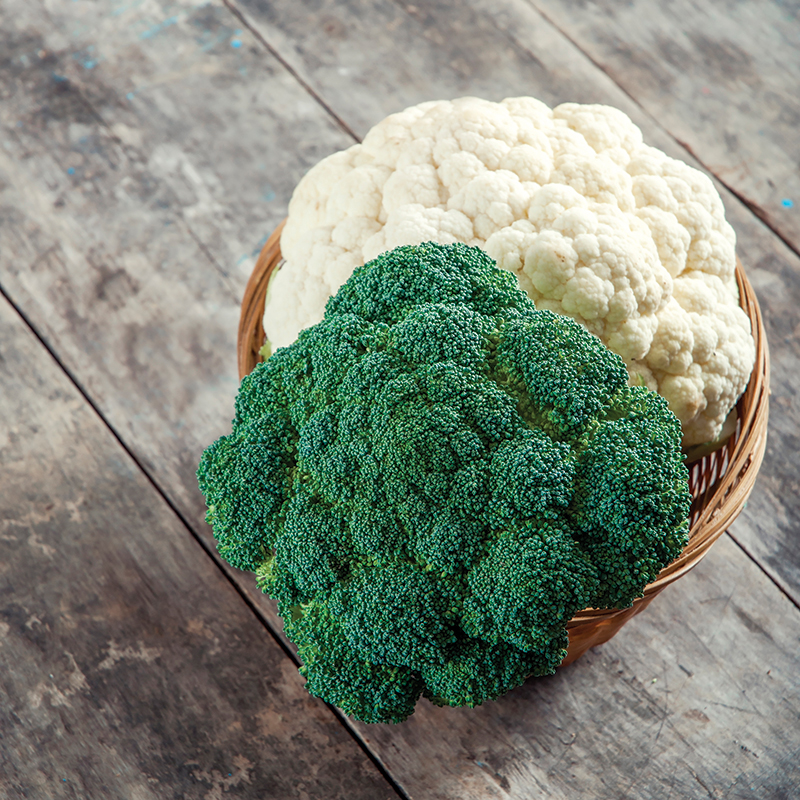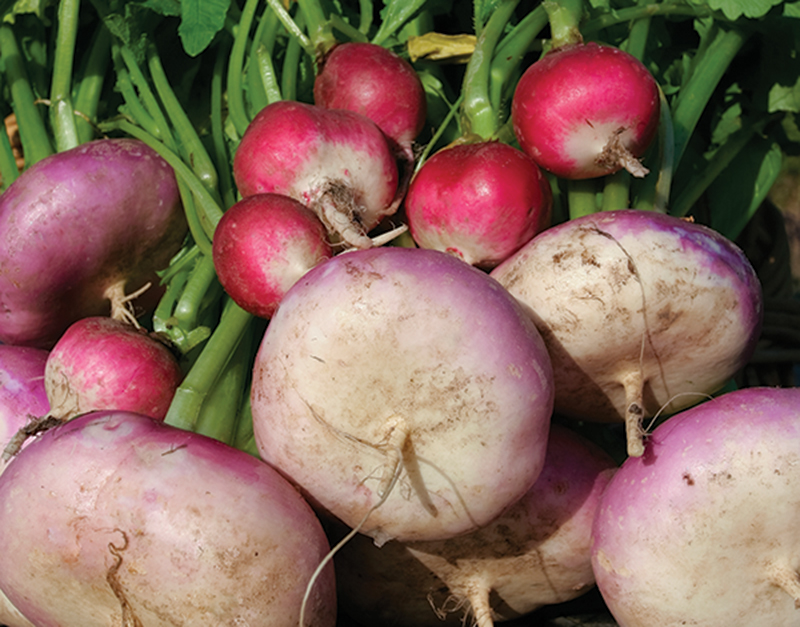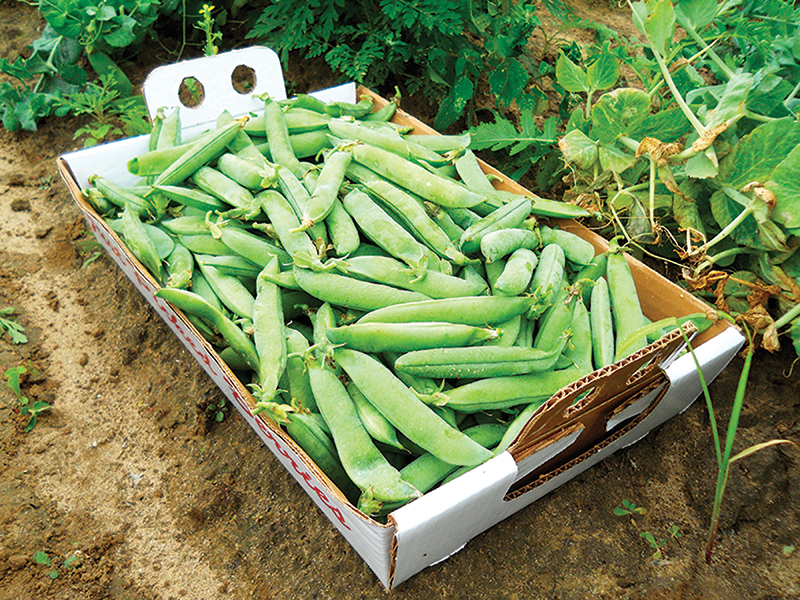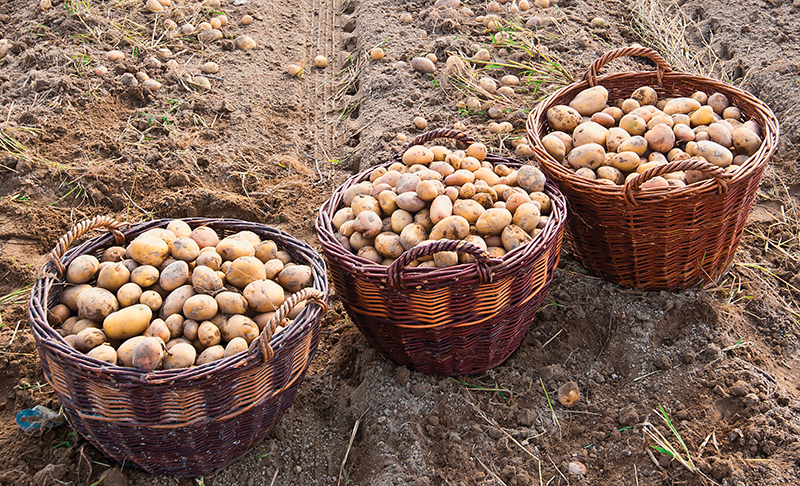
1. Cut Lettuce
Harvest: Cut early in the morning when dew is still on. Always use a sharp knife to avoid bruising leaves. Place in bins, and wash in cold water to remove grit and field heat, and gently spin dry.
Package: After spinning, pack lettuce into vented plastic bags or clam shells, or leave it loose for free-choice. Add your farm logo to the package at the end for a nice marketing touch.
Storage: Keep refrigerated at temperatures of around 32 degrees F. If it’s too cold, it will freeze, which damages the leaves; too warm, and it will begin to rot. It should be fully covered to keep from drying out
or wilting.

Other Considerations: At market, make sure lettuce doesn’t sit in direct sun. If loose, keep it out of the wind to avoid wilting.
2. Sweet Corn

Harvest: Pull ripe ears straight down to break away cleanly from stalk. Rip off excess stem to reduce waste and weight, then place ears facing down in bins or baskets.
Package: If planning to package corn in any sealed container, make sure it’s fully cooled. Corn respires heavily in first few hours and will begin to decompose rapidly.
Storage: As quickly as possible, store in a cooler of around 32 degrees F. Hotter temperatures can make the corn slimy.
Other Considerations: Because sweet corn diminishes in sweetness quickly, pick your corn no more than one day before market; the day of is ideal.
3. Heirloom Tomatoes

Harvest: Gently cut or pull ripe tomatoes from the vine. Place tomatoes in bins no more than two layers high—one layer, if tender. Transfer to a cooler for at least one hour to quickly remove field heat.
Package: Heirloom tomatoes are generally sold by the pound, individually, in containers or in boxes. Handle fruits gently, and don’t stack too high in boxes.
Storage: After removing the field heat, keep your tomatoes in the cooler, though temperatures between 37 to 55 degrees F—aka cellar temperatures—are preferred.
Other Considerations: If fruits are dusty or dirty, wipe them down. Don’t wash them or the skins may split. Also consider selling any damaged fruits as seconds or canning tomatoes.
4. Broccoli & Cauliflower

Harvest: Cut heads early in the morning while still cool. Leave at least a 2-inch stalk. Place in bins, and dunk in ice water for one minute to preserve.
Package: Don’t put either in plastic bags. Band them together, if small, but leave mostly whole and open.
Storage: These crops deteriorate fast in heat, so refrigerate at 32 degrees F but not below: Freezing will damage the crop.
Other Considerations: These crops are very prone to pests, so if you have issues with cabbage moths or harlequin beetles, make sure to thoroughly inspect each head.
5. Garlic

Harvest: Pull garlic when plant is 50 percent brown. Be gentle as bruises to cloves will turn into rot. Cut in field if hard-neck, and spread out in a single layer. Cure in dark room at room temperature with low humidity to increase longevity and avoid rot.
Package: Soft-neck garlic can be tied into knots and sold as wreaths. Otherwise, garlic is generally sold in individual bulbs or by the pound.
Storage: Cured garlic should be kept at cellar temperature in a dry, dark room to avoid germination, fungus or rot.
Other Considerations: Garlic can be sold in many ways: as baby garlic, green garlic, garlic scapes (the flower stem off hard-necks) and cured garlic; experiment with all of them to get the most out of your crop.
6. Radishes & Turnips

Harvest: Harvest several plants at a time, pick off bad leaves and bunch them with rubber bands in the field. Dunk bunches in a bucket of water, and stack in bins.
Package: Don’t package radishes or turnips beyond bunches, but make sure each bunch is clean, which may require a second rinsing.
Storage: Store at 32 degrees F before market for longest shelf life.
Other Considerations: Keeping these crops moist at market is the key to selling them. It’s nice to bring a food-safe tub of ice water to periodically refresh them.
7. Peas

Harvest: Early in the morning when peas are still cool, harvest ripe pods into baskets or bins. To preserve sweetness and remove field heat, place peas immediately into cold water.
Package: Peas can be sold in bulk or in bags. If prebagging, rapidly dry peas and place in bags of equal weight. They can also be sold in pints or quarts at market.
Storage: Peas respire heavily and should be kept at temperatures of 32 degrees F as long as possible. Bring a cooler to market, and restock as needed. Keep bags out of sun.
Other Considerations: For highest-
quality peas, harvest as close to market as possible; the day of is ideal.
8. Potatoes

Harvest: They should be plowed or forked up out of rows. Brush dirt off, but don’t clean. Place in baskets/bins. Cure in cool (55 to 60 degrees F), dark, humid place for two weeks or sell as new potatoes.
Package: Potatoes are generally sold by the pound, but smaller potatoes can be sold in berry containers. All potatoes can be sold in small burlap sacks.
Storage: Once cured, store in cellar temperatures of 50 to 55 degrees F. Make sure no light can get to them. Though many varieties will last several months in these conditions, check weekly for rotting tubers.
Other Considerations: If selling at a market, growing a variety of fingerling and large potatoes makes for a nice market display. Make sure to charge appropriately for specialty potatoes to ensure a profit.
9. Melons

Harvest: When the tendril adjacent to the stem is dry, harvest melons into bins or baskets. Don’t pile too high, and place in a cooler to remove field heat.
Package: Melons are sold in bulk, generally by the pound or as individual fruits. Some write the weight and price on the melon rind, though a sticker or tag may be more appealing.
Storage: Melons will keep for several days in a cooler around 27 to 32 degrees F. If space is not available, keep them as close to cellar temperature as possible.
Other Considerations: Because they’re both space- and time-
intensive, melons are not a high-profit item. It’s worth having an outlet for all melons before growing, such as a CSA, restaurant or retail shop.
10. Cucumbers

Harvest: Clip ripe cucumbers from vines, and place in bins or baskets. Separate damaged cucs for home use. Wash, then immediately cool to remove field heat.
Package: Cucs are typically sold by the pound, individually or in containers as specialty crops. If selling in pints or quarts, package at market to save space.
Storage: After field heat is off—store in a cooler for a minimum of one hour—keep at cellar temps above 50 degrees F for longest life.
Other Considerations: Cucs look best when moist. Spritz them with a spray bottle at the market. Consider bringing a variety of sizes.
This story originally appeared in the July/August issue of Hobby Farms magazine.




